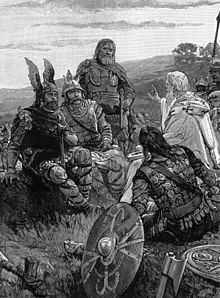Ulfilas
Ulfilas 𐍅𐌿𐌻𐍆𐌹𐌻𐌰 Wulfila | |
|---|---|
 Wulfila explaining the Gospels to the Goths | |
| Born | ca. 311 |
| Died | 383 |
| Children | (adopted) Auxentius of Durostorum |
| Writings | translated the Bible into Gothic |
Offices held | Bishop of the Goths |
Ulfilas (Gothic: 𐍅𐌿𐌻𐍆𐌹𐌻𐌰; Wulfila; "Little Wolf"), also Ulphilas, Orphila[1] (ca. 311 – 383[2]), bishop, missionary, and Bible translator, was a Goth of Greek descent from Cappadocia who had spent time inside the Roman Empire at the peak of the Arian controversy.
Biography
Ulfilas' parents were of non-Gothic Cappadocian Greek origin,[3][4] but had been enslaved by Goths and Ulfilas may have been born into captivity or made captive when young.[5] Raised as a Goth, he later became proficient in the Greek and Latin languages.[5] Ulfilas converted many among the Goths, preaching an Arian Christianity, which, when they reached the western Mediterranean, set them apart from their Orthodox neighbors and subjects.
Ulfilas was ordained a bishop by Eusebius of Nicomedia and returned to his people to work as a missionary. In 348, to escape religious persecution by a Gothic chief, probably Athanaric[6] he obtained permission from Constantius II to migrate with his flock of converts to Moesia and settle near Nicopolis ad Istrum in modern northern Bulgaria. There, Ulfilas translated the Bible from Greek into the Gothic language. For this he devised the Gothic alphabet.[7] Fragments of his translation have survived, notably the Codex Argenteus held since 1648 in the University Library of Uppsala in Sweden. A parchment page of this Bible was found in 1971 in the Speyer Cathedral.[8] According to Carolus Lundius,[9] Ulfilas created the Gothic alphabet based on the Getae's alphabet, with minor alterations. Carolus is quoting Bonaventura Vulcanius' book, De literis et lingua Getarum sive Gothorum, (Lyon, 1597) and Johannes Magnus, Gothus, Historia de omnibus Gothorum Sueonumque regibus, Roma, 1554, a book in which it has been published, for the first time, both the Getic alphabet, and the laws of the Getae legislator Zamolxis.
Historical sources
| Part of a series of articles on |
| Arianism |
|---|
 |
| History and theology |
| Arian leaders |
| Other Arians |
|
| Modern semi-Arians |
| Opponents |
|
| Christianity portal |
There are five primary sources for the study of Ulfilas's life. Two are by Arian authors, three by Catholics.[10]
- Arian sources
- Life of Ulphilas in the Letter of Auxentius
- Remaining fragments of Historia Ecclesiastica by Philostorgius
- Catholic sources
There are significant differences between the stories presented by the two camps. The Arian sources depict Ulfilas as an Arian from childhood. He was then consecrated as a bishop around 340 and evangelized among the Goths for 7 years during the 340s. He then moved to Moesia (within the Roman Empire) under the protection of the Arian Emperor Constantius II. He later attended several councils and engaged in continuing religious debate. They date his death in 383.
The accounts by the Catholic historians differ in several details, but the general picture is similar. According to them, Ulfilas was an orthodox Christian for most of his early life. He was only converted to Arianism somewhere around 360, and then only because of political pressure from the pro-Arian ecclesiastical and governmental powers. The sources differ in how much they credit Ulfilas with the conversion of the Goths. Socrates Scholasticus gives Ulfilas a minor role, and instead attributes the mass conversion to the Gothic chieftain Fritigern, who adopted Arianism out of gratitude for the military support of the Arian emperor. Sozomen attributes the mass conversion primarily to Ulfilas, though he also acknowledges the role of Fritigern.
For several reasons, modern scholars depend more heavily on the Arian accounts than the Catholic accounts. Auxentius was clearly the closest to Ulfilas, and so presumably had access to more reliable information. The Catholic accounts differ too widely among themselves to present a unified case. Debate continues as to the best reconstruction of Ulfilas's life.
The Creed of Ulfilas
The creed of Ulfilas, which concludes a letter praising him written by his foster-son and pupil Auxentius of Durostorum (modern Silistra) on the Danube, who became bishop of Milan, distinguishes God the Father ("unbegotten") from God the Son ("only-begotten"), who was begotten before time and who created the world, and the Holy Spirit, proceeding from the Father and the Son:
I, Ulfila, bishop and confessor, have always so believed, and in this, the one true faith, I make the journey to my Lord; I believe in one God the Father, the only unbegotten and invisible, and in his only-begotten son, our Lord and God, the designer and maker of all creation, having none other like him (so that one alone among all beings is God the Father, who is also the God of our God); and in one Holy Spirit, the illuminating and sanctifying power, as Christ said after his resurrection to his apostles: "And behold, I send the promise of my Father upon you; but tarry ye in the city of Jerusalem, until ye be clothed with power from on high" (Luke 24:49) and again "But ye shall receive power, when the Holy Ghost is come upon you" (Acts 1:8); being neither God (the Father) nor our God (Christ), but the minister of Christ ... subject and obedient in all things to the Son; and the Son, subject and obedient in all things to God who is his Father ... (whom) he ordained in the Holy Spirit through his Christ.[11]
Maximinus, a 5th-century Arian theologian, copied Auxentius' letter, among other works, into the margins of one copy of Ambrose's De Fide; there are some gaps in the surviving text.[12]
Honours
Wulfila Glacier on Greenwich Island in the South Shetland Islands, Antarctica is named after Bishop Ulfilas.
See also
Notes and references
- ↑ Bennett, William H. An Introduction to the Gothic Language, 1980, p. 23.
- ↑ Van Kerckvoorde, Colette M. (June 1993). An Introduction to Middle Dutch. Walter de Gruyter. p. 105. ISBN 3-11-013535-3.
- ↑ Fried, Johannes (2015). The Middle Ages. Harvard University Press. p. 10. ISBN 9780674055629.
One of their own number, Bishop Ulfilas, a Goth who originally came from a Greek-Cappadocian family, translated the Holy Gospel into the Gothic vernacular – an enormous undertaking and a work of true genius.
- ↑ Berndt, Dr Guido M (2014). Arianism: Roman Heresy and Barbarian Creed. Ashgate Publishing, Ltd. p. 57. ISBN 9781409446590.
Though ulfila may have spoken some Greek in his own family circle, since they were of Greek origin, he is likely to have been able to draw on formal education in both latin and Greek in creating Gothic as a literary language.
- ↑ 5.0 5.1 Noel Harold Kaylor; Philip Edward Phillips (3 May 2012), A Companion to Boethius in the Middle Ages, BRILL, pp. 9–, ISBN 978-90-04-18354-4, retrieved 19 January 2013
- ↑ Mastrelli, Carlo A. Grammatica Gotica, p. 34.
- ↑ Socrates of Constantinople, Church History, book 4, chapter 33.
The Gothic alphabet was a modified Greek alphabet; see Wright, Joseph A Primer of the Gothic Language with Grammar, Notes, and Glossary, p. 2.
The most complete Gothic texts borrow elements from the Roman alphabet; see Bennett, William H. An Introduction to the Gothic Language, p. 126. - ↑ http://www.goruma.de/Wissen/KunstundKultur/WelterbestaettenUNESCO/Unesco_Welterbestaetten_Deutschland/kaiser_mariendom_speyer.html
- ↑ See Carolus Lundius, Zamolxis, Primus Getarum Legislator, Upsala 1687
- ↑ For an overview and evaluation of the historical sources, see Hagith Sivan, "Ulfila’s Own Conversion," Harvard Theological Review 89 (October 1996): pp. 373–86.
- ↑ Heather and Matthews, Goths in the Fourth Century, p. 143.
- ↑ Heather and Matthews, Goths in the Fourth Century, pp. 135-137.
External links
- Streitberg's edition of Ulfilas' Bible
- Jim Marchand's translation on Auxentius' letter on Ulfilas' career and beliefs, with Latin text
- Project Wulfila
- Gothic fonts after Ulfilas
- ULFILAS, THE APOSTLE OF THE GOTHS by CHARLES A. ANDERSON SCOTT in BTM format
|